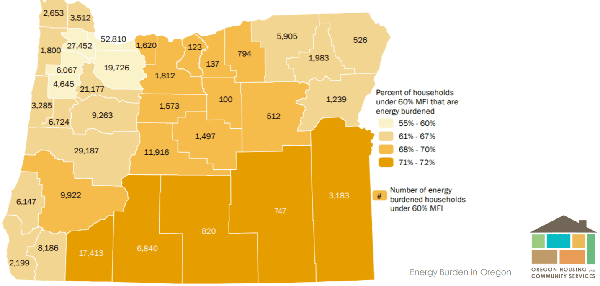What is Energy Burden and What is Oregon Doing About It?
Posted on July 12, 2022 by Charlotte Shuff
Tags, Energy

Here at CUB, we often talk about making Oregon’s utilities more affordable. But what does “affordable” really mean when it comes to a household’s energy bills?
In this blog, we will discuss a standard measure for when energy is unaffordable, called energy burden. We’ll also highlight a few new programs designed to help Oregon customers.
What is Energy Burden?
If your household’s energy costs are $160 per month, is that affordable? The answer depends on how much money your household brings in each month. No single dollar amount is going to be affordable for everyone, particularly when thinking about low-income households.
For that reason, energy burden is measured as a percentage. Energy burden refers to the percent of your total household income that you spend on energy costs. Most Oregon government agencies consider a home energy burdened at 6 percent of income going to energy costs. If a household spends more than 10 percent of its income on energy, it is considered extremely energy burdened.
So that $160 monthly energy bill? Households that make less than $32,200 per year would be considered energy burdened. A full-time job at $15 per hour pays $32,200 per year. Many Oregonians make much less than this amount each year.
How Big a Problem is Energy Burden in Oregon?
For low-income households, energy burden is extremely prevalent across the state. In Southern and Eastern Oregon, the rates are even higher.
The map below, from Oregon Housing and Community Services, shows the percentage of households making 60 percent of the Median Family Income that are burdened. This income level is the same as the ceiling for qualifying for energy assistance.

Source: Oregon Housing and Community Services
In 2018, Oregon’s energy burden totaled $345,733,243 for low-income households according to a joint state agency report. By contrast, energy assistance programs through Oregon Housing and Community Services had $55,000,000 in funding. Assistance programs can only cover about 20 percent of the need.
Racial Disparities in Energy Burden
Energy burden also disproportionately impacts communities of color. According to the American Council for an Energy-Efficient Economy, the difference is stark for Black, Native American, and Hispanic households. These communities are already more likely to have lower incomes and live in inefficient housing.

Source: aceee.org/energy-burden
As we seek to solve issues that contribute to energy burden, we must listen to and uplift those most affected by this inequality. In recent years, BIPOC communities in Oregon have led the charge in addressing energy affordability and energy justice.
What are the Impacts of Energy Burden?
Energy bills are a common pain point for many households. When bills are too high, many families have to choose between keeping the lights and heat on and other household necessities. In 2015, about one in five US households had to reduce or forgo basic necessities like food and medicine to pay an energy bill (Residential Energy Consumption Survey).
According to a recent report from Just Solutions Collective, energy burden can also correlate to worse health outcomes:
“Energy-inefficient homes are a significant contributor to high energy burdens. Many low-income consumers live in energy-inefficient homes, with substandard insulation or older appliances, which can mean they have a higher energy cost burden than wealthier families even though, on average, they live in smaller homes. The inefficiency shows up as higher energy use per square foot of home and therefore higher cost per square foot. Many low-income households are also renters and—compared to homeowners—may have less control over the quality of their housing. Furthermore, high energy burdens are correlated with greater risk for respiratory diseases, increased stress, and economic hardship, including difficulty moving out of poverty.”
What Is Being Done to Address Energy Burden in Oregon?
Low-Income Energy Bill Discounts: Starting in 2022, customers of Portland General Electric, Pacific Power, Idaho Power, and Oregon’s natural gas utilities may be eligible for bill discounts. Qualifying customers can sign up to lower their bills. These programs are thanks to the Energy Affordability Act. More information about programs and how to sign up:
- Portland General Electric (now available)
- Pacific Power (starting August 1, 2022)
- Idaho Power (starting date TBD)
- Cascade Gas (now available)
- NW Natural Gas (starting October 2022)
- Avista Gas (starting October 2022)
Energy Affordability Act: In 2021, the Oregon Legislature passed the Energy Affordability Act thanks to advocacy by a diverse coalition, including CUB. This law will help customers of Oregon’s major energy utilities who struggle to afford their bills. Now, regulators can consider income and related social factors when determining customers’ energy rates and developing other programs.
This law also helps expand advocacy at the Public Utility Commission by opening funding opportunities for organizations that represent environmental justice communities. By prioritizing these communities, those most impacted by energy burden can now have a stronger voice in utility policy.
Portland Clean Energy Fund: In 2018, a broad coalition led by the Coalition of Communities of Color worked to pass the Portland Clean Energy Fund. The Portland Clean Energy Fund “will distribute approximately $50 million each year to support projects like solar panels, living-wage job training, trees and urban gardens, and home upgrades including better insulation, heating and cooling, and energy efficiency.”
This innovative policy will help reduce energy burden by funding energy efficiency programs. These programs are also specifically designed to benefit BIPOC communities.
CUB will continue to work with our partner organizations to make Oregon utilities affordable, accessible, reliable, and clean. For regular updates on our work, sign up for our email newsletter.
To keep up with CUB, like us on Facebook and follow us on Twitter!





07/12/22 | 0 Comments | What is Energy Burden and What is Oregon Doing About It?